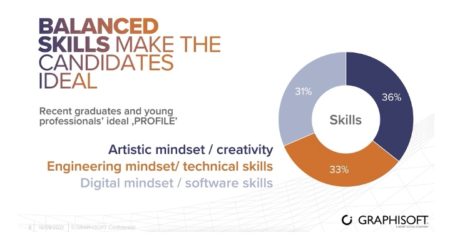Nemetschek Group company Graphisoft announced that their “Hiring the next generation of architects’ global recruitment survey”—the first of its kind in the AEC industry—revealed that BIM knowledge is the most sought-after skill. This study was also the subject of a session at Graphisoft’s Building Together Digital Event.
Over 1,100 Responses
The survey went out to architecture firms around the world, from over 54 countries. The firm composition matched the overall market conditions in terms of firm sizes, representing an accurate snapshot of the global industry (60 percent small firms / 18 percent medium firms / 22 percent large firms).
Balanced Skills Are Ideal
Firms report that they seek “balanced skills” in new grads. According to 39 percent of firms participating in the study (essentially 4 out of 10 firms), current job candidates lack a good balance of three core skill areas. These skill areas are:
- Artistic mindset/creativity
- Engineering mindset/technical skills
- Digital mindset/software skills
Graphisoft sees these three mindsets as part of a BIM mindset, something we will discuss below in the analysis section.
BIM Mindset
66 percent of respondents responsible for hiring new recruits reported that BIM knowledge is the most important requirement, while a BIM Mindset was a close second at 59 percent. Essentially, 6 out of 10 firms are saying that the most important aspect of a new recruit is BIM knowledge and a BIM mindset. Building Information Modeling (BIM) skills, knowledge, and orientation are more valued than any other skillset range in recruitment for more than half of all firms globally.
“To help firms find great talent, we asked employers what the main roadblocks are when recruiting recent architecture school graduates,” said Szabolcs Miko, Manager, Global Education at Graphisoft. “49 percent of respondents said that job candidates lack proficiency in BIM, while 39 percent said that recruits don’t even have a BIM mindset.”
Training for BIM
The survey revealed that employers support acquiring BIM software skills through on-the-job training (69 percent), internal training (53 percent), and external, third-party training (40 percent).

Graphisoft’s global BIM study reveals a consistent focus on what constitutes the best balance of skills and mindset for new grads.
“The survey shows just how important BIM is in educating the architects of the future,” said Huw Roberts, Graphisoft CEO. “Graphisoft is committed to closing the gap in architecture education by offering Archicad free to students, giving them the tools they need to successfully compete on the job market.”
To learn more about Graphisoft visit here.
Architosh Analysis and Commentary
Graphisoft’s Building Together virtual conference had two interrelated sessions on the topic of BIM knowledge acquisition and the next generation of architects. The first session was called “Hiring the Next Generation of Architects.” The second session was titled, “Educating Architects: The Challenges of Integrating BIM in the Curriculum.”
The first session focused on discussing the results of Graphisoft’s global study. The second session was a fascinating moderated panel discussion with five architectural professors from multiple countries. This provided a global sense of BIM’s importance in the education of the next generation of architects.
Eduardo Rolón’s View
In this session, two interesting thoughts emerged in contrast to each other. Eduardo Rolón, AIA, NCARB, Director of the Digital Studio, School of Architecture of the Polytechnic University of Puerto Rico, said that at his university they introduce BIM through a procession of small steps leading up to BIM, starting with analog drawing and drafting, 2D CAD, 3D modeling and then finally BIM.
“It is important because when you integrate BIM into the process you ultimately need more time for design,” said Rolón. He emphasized that students are not there to learn a software package, nor learn to be architectural draftsmen. “They are there to become designers and architects,” he emphasized. Eduardo Rolón is stressing two interrelated aspects of an architect’s education and ultimately its social role or purpose. One is that the core training and education of a designer and architect is optimal when there is a wide spectrum and openness to multiple modalities of understanding the field of architecture. The second interrelated piece is about time. He notes that integrating BIM into the process requires more time for design.

The panelists were from countries around the world, reflecting the survey data which was global as well.
Eduardo Rolón emphasized that given students’ precious time in school, each tool should give students more time for design and reduce their time generating documentation of their design solutions. Eduardo Rolón doesn’t seem to be making this point because he is concerned about the economics of the profession. However, that is exactly what digital tools should be doing first and foremost for practicing architects. Rather, he is emphasizing the importance of time to the study of architecture and the importance of time to the quality and innovation of design.
Kimmo Liimatainen’s View
Kimmo Liimatainen, Architect at SAFA, had a position that reflected much of other panel participants’ views. Largely as he put it, “in my mind, there is no other way of doing building than with BIM,” noting that in the end [the process] is about the communication of the project…without good communication, you end up with problems during construction.”
Unlike Eduardo Rolón, he does not feel that the architectural curriculum is overloaded. This view was mostly his and other panelists who agreed with the importance of BIM integration into the curriculum early did not necessarily share this view. Professor Sven Pfeiffer, Head of Digital Design, Planning and Construction, Bochum University, stated that the design process has changed significantly and in the current context “we live in a data-driven world now.” This point emphasizes the “I” in BIM, which longtime Architosh readers will recall from our 2010 BIM study was a letter we optionally could have called something else (like “I” for Innovation) because a decade ago information [in BIM models] wasn’t being recognized by clients for the value it really contained and architects were not going to spend time inputting data if there was no downstream use for it or compensation for the input.

The panelists from the “Educating Architects: The Challenges of Integrating BIM in the Curriculum” session.
Other panelists felt that BIM should be fully integrated into the academic experience from day one for reasons such as concerns about the job market, lack of qualified candidates for a BIM-oriented workforce, and because BIM offers learning advantages for architecture students. Can BIM as a type of “digital replica” teach students about construction?
Professor Marco Casini, Associate Professor in Technology of Architecture, Sapienza University of Rome, Italy, said that architecture is a “frontier art” and that “the architect must continually reinvent himself to use tools and instruments of his era.” He also believes that the mega-trends of our current time require a “different building environment” and that BIM is a foundational tool best prepared to respond to the needs of this different building environment.
Closing Comments
For those who want to hear out this discussion (far more a discussion than a debate) about integrating BIM into an architect’s education, sign-up for the Graphisoft Building Together virtual conference and watch the session on-demand. But before you go here are some final thoughts and questions.
If “time” is indeed the most precious commodity in architectural education and if the curriculum is already overloaded, how can BIM and BIM education change to address this? Does BIM-mindedness require students to actually learn one of the half-dozen BIM authoring tools from the first semester or can students gain a “BIM-minded” orientation another way and perhaps with other tools that expose the importance of how BIM is foundational to the field of architecture pivoting for a changing building environment?
Can students learn the basics of design in the classical model (as Eduardo Rolón mentioned in small steps) and use the appropriate tools for those steps and at the same time learn about why and how BIM technology better addresses our “different building environment” that professor Casini notes? He is, of course, referring to the performative nature of buildings in the era of climate change urgency. He may also be referring to the present context of the convergence of industries, the use of robotics, AI, VR/AR/XR, computer vision, automation, and most importantly, Design for Manufacture and Assembly (DfMA) which entirely alters the model definition of what architects do—deliver not a “buildable design” but deliver “design intent.”
The profession of architecture is at a crucial point because Prof. Marco Casini is absolutely correct about megatrends that have changed our building environment, ushering in new economic inputs and outputs. And speaking of economics…
Economics is the one academic area that is most needed in an architect’s education. And from day one. Architecture students need to learn from day one that time is precious and most of all extraordinarily valuable to the output potential and impact of architects. The profession can no longer afford the frivolous wasting of an architect’s time. This is why Prof. Eduardo Rolón has stated perhaps the most important point. The tools used for design must be low-impact on a student’s precious time and high-impact on the delivery of their ideas via their output for crits. That economic understanding needs to run from the first semester through the rest of their careers and they must become educated to do the analysis of how their digital tools measure up against this criteria.




Reader Comments
Comments for this story are closed